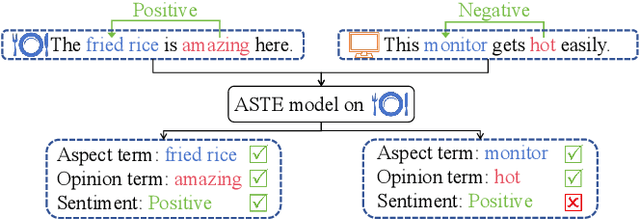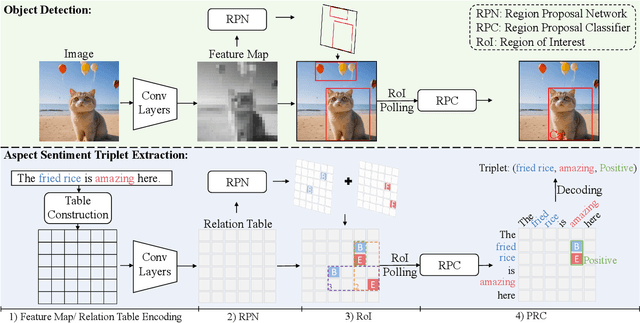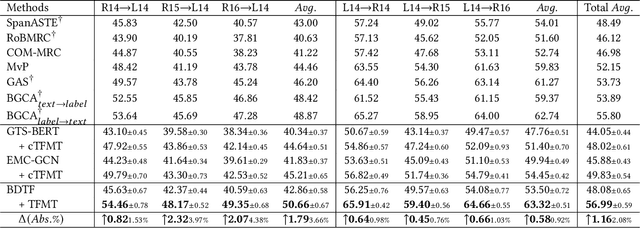Kun Peng
Emotion Transfer with Enhanced Prototype for Unseen Emotion Recognition in Conversation
Aug 27, 2025Abstract:Current Emotion Recognition in Conversation (ERC) research follows a closed-domain assumption. However, there is no clear consensus on emotion classification in psychology, which presents a challenge for models when it comes to recognizing previously unseen emotions in real-world applications. To bridge this gap, we introduce the Unseen Emotion Recognition in Conversation (UERC) task for the first time and propose ProEmoTrans, a solid prototype-based emotion transfer framework. This prototype-based approach shows promise but still faces key challenges: First, implicit expressions complicate emotion definition, which we address by proposing an LLM-enhanced description approach. Second, utterance encoding in long conversations is difficult, which we tackle with a proposed parameter-free mechanism for efficient encoding and overfitting prevention. Finally, the Markovian flow nature of emotions is hard to transfer, which we address with an improved Attention Viterbi Decoding (AVD) method to transfer seen emotion transitions to unseen emotions. Extensive experiments on three datasets show that our method serves as a strong baseline for preliminary exploration in this new area.
Dialogues Aspect-based Sentiment Quadruple Extraction via Structural Entropy Minimization Partitioning
Aug 07, 2025Abstract:Dialogues Aspect-based Sentiment Quadruple Extraction (DiaASQ) aims to extract all target-aspect-opinion-sentiment quadruples from a given multi-round, multi-participant dialogue. Existing methods typically learn word relations across entire dialogues, assuming a uniform distribution of sentiment elements. However, we find that dialogues often contain multiple semantically independent sub-dialogues without clear dependencies between them. Therefore, learning word relationships across the entire dialogue inevitably introduces additional noise into the extraction process. To address this, our method focuses on partitioning dialogues into semantically independent sub-dialogues. Achieving completeness while minimizing these sub-dialogues presents a significant challenge. Simply partitioning based on reply relationships is ineffective. Instead, we propose utilizing a structural entropy minimization algorithm to partition the dialogues. This approach aims to preserve relevant utterances while distinguishing irrelevant ones as much as possible. Furthermore, we introduce a two-step framework for quadruple extraction: first extracting individual sentiment elements at the utterance level, then matching quadruples at the sub-dialogue level. Extensive experiments demonstrate that our approach achieves state-of-the-art performance in DiaASQ with much lower computational costs.
T-T: Table Transformer for Tagging-based Aspect Sentiment Triplet Extraction
May 08, 2025Abstract:Aspect sentiment triplet extraction (ASTE) aims to extract triplets composed of aspect terms, opinion terms, and sentiment polarities from given sentences. The table tagging method is a popular approach to addressing this task, which encodes a sentence into a 2-dimensional table, allowing for the tagging of relations between any two words. Previous efforts have focused on designing various downstream relation learning modules to better capture interactions between tokens in the table, revealing that a stronger capability to capture relations can lead to greater improvements in the model. Motivated by this, we attempt to directly utilize transformer layers as downstream relation learning modules. Due to the powerful semantic modeling capability of transformers, it is foreseeable that this will lead to excellent improvement. However, owing to the quadratic relation between the length of the table and the length of the input sentence sequence, using transformers directly faces two challenges: overly long table sequences and unfair local attention interaction. To address these challenges, we propose a novel Table-Transformer (T-T) for the tagging-based ASTE method. Specifically, we introduce a stripe attention mechanism with a loop-shift strategy to tackle these challenges. The former modifies the global attention mechanism to only attend to a 2-dimensional local attention window, while the latter facilitates interaction between different attention windows. Extensive and comprehensive experiments demonstrate that the T-T, as a downstream relation learning module, achieves state-of-the-art performance with lower computational costs.
Table-Filling via Mean Teacher for Cross-domain Aspect Sentiment Triplet Extraction
Jul 23, 2024



Abstract:Cross-domain Aspect Sentiment Triplet Extraction (ASTE) aims to extract fine-grained sentiment elements from target domain sentences by leveraging the knowledge acquired from the source domain. Due to the absence of labeled data in the target domain, recent studies tend to rely on pre-trained language models to generate large amounts of synthetic data for training purposes. However, these approaches entail additional computational costs associated with the generation process. Different from them, we discover a striking resemblance between table-filling methods in ASTE and two-stage Object Detection (OD) in computer vision, which inspires us to revisit the cross-domain ASTE task and approach it from an OD standpoint. This allows the model to benefit from the OD extraction paradigm and region-level alignment. Building upon this premise, we propose a novel method named \textbf{T}able-\textbf{F}illing via \textbf{M}ean \textbf{T}eacher (TFMT). Specifically, the table-filling methods encode the sentence into a 2D table to detect word relations, while TFMT treats the table as a feature map and utilizes a region consistency to enhance the quality of those generated pseudo labels. Additionally, considering the existence of the domain gap, a cross-domain consistency based on Maximum Mean Discrepancy is designed to alleviate domain shift problems. Our method achieves state-of-the-art performance with minimal parameters and computational costs, making it a strong baseline for cross-domain ASTE.
Prompt Based Tri-Channel Graph Convolution Neural Network for Aspect Sentiment Triplet Extraction
Dec 24, 2023Abstract:Aspect Sentiment Triplet Extraction (ASTE) is an emerging task to extract a given sentence's triplets, which consist of aspects, opinions, and sentiments. Recent studies tend to address this task with a table-filling paradigm, wherein word relations are encoded in a two-dimensional table, and the process involves clarifying all the individual cells to extract triples. However, these studies ignore the deep interaction between neighbor cells, which we find quite helpful for accurate extraction. To this end, we propose a novel model for the ASTE task, called Prompt-based Tri-Channel Graph Convolution Neural Network (PT-GCN), which converts the relation table into a graph to explore more comprehensive relational information. Specifically, we treat the original table cells as nodes and utilize a prompt attention score computation module to determine the edges' weights. This enables us to construct a target-aware grid-like graph to enhance the overall extraction process. After that, a triple-channel convolution module is conducted to extract precise sentiment knowledge. Extensive experiments on the benchmark datasets show that our model achieves state-of-the-art performance. The code is available at https://github.com/KunPunCN/PT-GCN.
 Add to Chrome
Add to Chrome Add to Firefox
Add to Firefox Add to Edge
Add to Edge